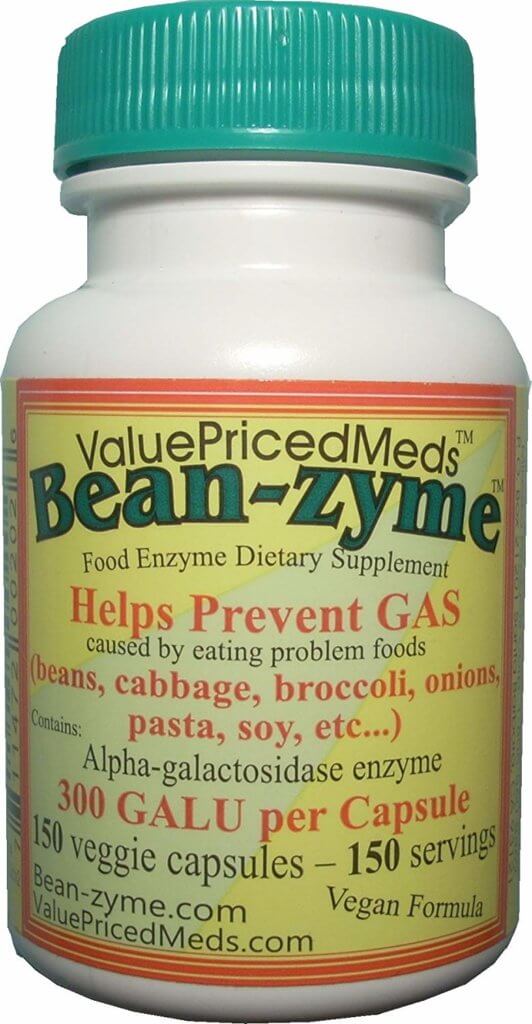TVP is a great protein source for vegan athletes.
It has tons of protein with relatively few overall calories make it one of the best vegan protein sources overall. Side note: Soy curls are made out of TVP, it’s just a different shape.
Unfortunately, some people have issues with TVP and gas. That doesn’t mean that TVP is unhealthy, but it’s inconvenient.
Let’s go over why this happens, and 4 potential solutions to this problem.
Table of Contents
Why Does TVP Cause Gas and Stomach Issues?
The main ingredient in TVP is typically soy flour, although it can contain other vegetable proteins.
Because of this, it can cause your body to produce gas, in the same way that tofu can cause gas. There are 3 main culprits:
- Fiber Content: TVP is a good source of dietary fiber, but an increase in fiber intake leads to more gas production in the gut. Fiber broken down in the colon by bacteria, which produce gases as a byproduct. Gradually increasing fiber intake and drinking plenty of water can help the digestive system adapt.
- Oligosaccharides: Soybeans contain oligosaccharides, a type of carbohydrate that is hard to digest and is linked to flatulence. These compounds are not fully broken down in the small intestine and are fermented by bacteria in the colon, producing gas as a result. Soaking or cooking soybeans can help reduce the oligosaccharide content.
- Individual Sensitivity: Some people may be more sensitive to certain components of soy, and their digestive systems may react with gas production. It’s possible that individual variations in gut microbiota or enzyme activity play a role in how soy products are digested.
Soak, Rinse and Squeeze Your TVP to Reduce Gas
It’s important to do all three of these steps:
- Soak in hot water (boiling ideally) for 5-10 minutes
- Drain and then squeeze the TVP to drain even more
- Then do a final thorough rinse of the TVP before cooking
Some brands write this out clearly on their packaging, but many don’t. And if you buy TVP from a bulk store, it may not have any cooking instructions at all.
Why might this reduce gas?
TVP is made from soybeans, and soybeans (like other beans) often give people gas. This is partly because of fiber, and partly because of things like phytic acid.
I’m not sure of the exact mechanism, but soaking beans in water can extract some of the phytic acid so you can drain it away. This is why soaking beans can reduce gas.
The same idea applies here since TVP is made from soybeans. Soaking and rinsing them can help you get rid any problem substances on or near the surface of your TVP.
If You’re New to TVP, Gas Will Get Better Over Time
If you’ve never had TVP before, whether you’re a new vegan or just experimenting, some bad gas is to be expected.
It takes time for the bacteria in your gut to adapt to new foods, and certain foods (like bean products) will give you more issues than others.
This adaption process usually takes a few weeks to a few months depending on the individual, but you should see gradual improvement over this time.
Is There a Difference Between TSP and TVP?

TVP (Textured Vegetable Protein) and TSP (Textured Soy Protein) are often identical.
The biggest difference is that TVP can include other vegetable proteins, although soy is the most commonly used one.
Depending on how your TVP is made, it’s possible that the process used to make TSP ends up being easier on your stomach than the TVP.
Worth trying out both, and they taste extremely similar, so you can substitute one for another in recipes.
Take an Enzyme
This is my least preferred option because it’s kind of a pain to take an extra thing, but it is a good option.
Beano is a popular enzyme mix to help with stomach issues (although maybe not vegan).
If you’re vegan, Bean-Zyme is another popular option.

These products contain enzymes that help break down certain foods (most notably beans, as the names suggest) and significantly reduce gas in most people.
Not the most convenient, but very effective.
Finally, Consider What You’re Eating With TVP
If TVP causes you gas, it’s a good idea not to pair it with other foods that may also give you gas.
There are many great vegan TVP recipes, so try out different ones to see which ones are easiest on your stomach.
In general, you want to avoid eating foods that are high in fiber at the same time:
- Certain grains – Rye and buckwheat groats both have a ton of fiber.
- Other legumes – Most TVP recipes won’t be paired with other legumes, but some do.
- Seeds – While very healthy in general, eating too many seeds (e.g. flax, pumpkin, chia) can cause gas.
Some people also have sensitives (even if they don’t have IBS) to foods like tomatoes or chocolate. See this guide to low FODMAP foods for more detail.
When you’re first trying to get used to TVP, start with a very basic recipe like TVP and rice with minimal seasoning. This is one of the cases where white rice may be preferable to whole grain (less fiber).
